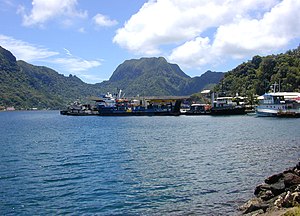Pago Pago, American Samoa: Difference between revisions
added section, removed personal musings |
m moved Pago Pago, American Samoa to Pago Pago over redirect: disambiguation not required |
(No difference)
| |
Revision as of 22:37, 2 June 2008
Pago Pago (IPA: [ˈpɑŋo ˈpɑŋo] by native Samoan-speakers and sometimes /ˈpɑŋgoʊ ˈpɑŋgoʊ/ by others) is the capital town of American Samoa. It is actually a village that is often mistaken to be a city (as in a capital or port city) of this south Pacific territory of the United States of America. Its 1990 population was 10,640. The village is located on Pago Pago Harbor, in the island of Tutuila. Tourism, entertainment, food, and tuna canning are the primary industries here. From 1878 to 1951, this was a coaling and repair station for the U.S. Navy.


Pago Pago is one of the several villages along the shore of the harbor and is located at the very back (inside) of the embayment. However, because the name Pago Pago is associated with the harbor itself — the only significant port of call in American Samoa — Pago Pago is now generally applied not only to the village itself, but to the whole harbor area and the whole town that encompasses the adjacent village of Fagatogo — the seat of the local territorial government.[1] It is in this sense that Pago Pago becomes the de facto capital town of American Samoa.
Pago Pago is a mixture of colorful semi-urban communities, a small town, tuna canneries (which provide employment for a third of the population of Tutuila) and a harbor surrounded by dramatic cliffs, which plunge almost straight into the sea. A climb to the summit of Mt. Alava (see National Park of American Samoa) provides a magnificent bird's-eye view of the harbor and town. Until 1980, one could experience the view from the peak by taking an aerial tramway over the harbor, but on June 14 of that year a U.S. Navy plane, flying overhead as part of the Flag Day celebrations, struck the cable; the plane then crashed into a wing of the Rainmaker Hotel. The tram remains unusable, although according to Lonely Planet, plans have been put forth to reopen it. Less spectacular, but worth the drive, is the view from the top of the pass above Aua Village on the road to Afono.
Both the port itself and the legislature of American Samoa — known as the Fono (/ˈfono/) — are in Fagatogo, a village adjacent to Pago Pago. Similarly, the once famous Rainmaker Hotel (now closed) is in the village of Utule‘i, adjacent to Fagatogo along the south shore of the long harbor. The canneries are in Atu‘u, on the harbor's north shore. It is suggested that one must avoid eating any fish or invertebrate caught in Pago Pago Harbor because they are contaminated with heavy metals and other pollutants.[2]
References in Popular Culture
- The action of the W. Somerset Maugham story 'Miss Thompson' aka 'Rain' is set in Pago Pago.
- Some versions of the Careers board game with 'Go to Sea' as a career, have an opportunity to earn happiness in the square 'Terrific shore leave in Pago Pago'. Game designer James Cooke Brown may have intended this as a sly reference to the Maugham story.
External links
- Pago Pago, American Samoa National Weather Service Office
- Pago Pago Weather underground
- Photos of Pago-Pago - Terra Galleria
14°16′46″S 170°42′02″W / 14.27944°S 170.70056°W
References
- ^ "American Samoa Constitution". Congress of the United States - Congressman Eni Faleomavaega. Retrieved 2007-02-16.
- ^ "Natural History Guide To American Samoa". nps.org. Retrieved 2007-02-16.
